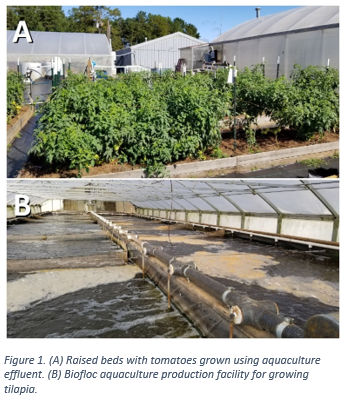PERFORMANCE OF AQUACULTURE EFFLUENT FOR TOMATO PRODUCTION IN OUTDOOR RAISED BEDS
Aquaculture is under great scrutiny as a source of nutrient pollution, specifically as a driver of eutrophication and harmful algal blooms in natural water bodies. The regulation of nutrient effluent is a major issue constricting the growth of the aquaculture industry in the US. Production facilities exceeding certain biomass load criteria are mandated to manage that effluent, which can be quite expensive and even cost prohibitive. Commercial field vegetable production techniques can be adapted to accept aquaculture effluent and grow crops for market.
In summer of 2019, effluent from a biofloc-style recirculating aquaculture system producing Nile Tilapia (Oreochromis niloticus) was used to perform two production trials in raised beds using tomato (Solanum lycopersicum) (figure 1). Each of the nine raised beds (6.1 m x 1.2 m x 0.3 m) and were filled with topsoil having a sandy loam to loamy sand texture. Irrigation lines were installed with one gallon per hour anti-clog drip emitters for each plant and set on a timer to water multiple times per day based on plant needs.
'Celebrity' tomatoes are a determinate, hybrid variety known for high yield, large size, excellent flavour and disease resistance. Differences in production were assessed for tomatoes grown using three different nutrient delivery techniques. Treatments included (1) a side-dressed granular fertilizer program, (2) fertigation with water-soluble nutrients, and (3) aquaculture effluent from a biofloc tilapia production system. Soil tests were conducted and raised beds were prepared with the appropriate amount of fertilizer for the production cycle, except for nitrogen, which was applied through the aquaculture effluent. Produce biomass, leaf greenness (SPAD), and foliar nutrient analysis data was collected as fruits reached marketable size. Comparative results will be presented.
